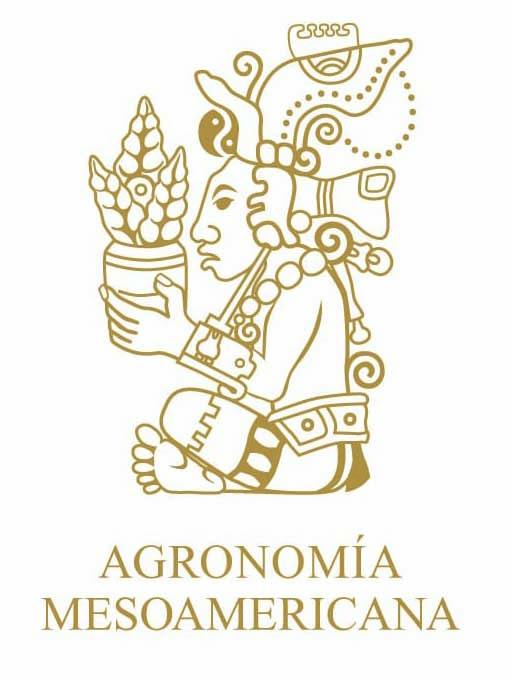Effect of aqueous extracts of quinoa mojuelo (Chenopodium quinoa Willd.) on arupo plants (Chionanthus pubescens Kunth)
DOI:
https://doi.org/10.15517/am.2025.62197Keywords:
Andean crop, damping-off, secondary metabolites, bio-fungicideAbstract
Introduction. Chionanthus pubescens Kunth is an endemic tree of southern Ecuador with ornamental uses in the villages of the region due to its pink inflorescence. Objective. To evaluate the effect of aqueous extracts of quinoa mojuelo (Chenopodium quinoa Willd.) on the growth of arupo plants (Chionanthus pubescens Kunth) and the incidence of Fusarium sp. Materials and methods. The trial was conducted in the province of Chimborazo, Ecuador, during 2022. Aqueous extracts of quinoa mojuelo were obtained using the Soxhlet method, and their concentrations were determined by UV-VIS spectrophotometry. A completely randomized block design with a bifactorial arrangement was used, with three levels for factor A (aqueous extract of mojuelo: mother extract at 100
%, and 50 % and 75 % dilutions in sterile distilled water; v/v) and three levels for factor B (application frequency: every 7, 14, and 21 days). Ten treatments were evaluated, including an absolute control, with three repetitions each. In ten randomly selected plants per treatment, morphological variables (height, number of leaves per plant, and stem diameter) were measured, as well as the incidence of Fusarium sp. Results. The 50 % and 75 % aqueous extract concentrations applied weekly promoted better morphological development and reduced the percentage of Fusarium sp. incidence in arupo plants, as reflected in height (16.3 cm), number of leaves (17.8), stem diameter (6.5 cm), and disease incidence (50 %). Conclusions. Aqueous extracts obtained from quinoa mojuelo applied to Chionanthus
pubescens Kunth plants in nursery conditions reduced the incidence of Fusarium wilt and favored their growth in the early stages of development.
Downloads
References
Abdelrahman, M., & Jogaiah, S. (2020). Isolation and characterization of triterpenoid and steroidal saponins. In M. Abdelrahman & S. Jogaiah (Eds.), Bioactive molecules in plant defense (pp. 59–78). Springer, Cham. https://doi.org/10.1007/978-3-030-61149-1_6 DOI: https://doi.org/10.1007/978-3-030-61149-1_6
Al-Mughrabi, K. I., Vikram, A., & Poirier, R. (2010). Effect of saponins of Chenopodium quinoa applied as seed or foliar treatments on dry rot, common scab and black scurf diseases of potato. The Americas Journal of Plant Science and Biotechnology, 4(2), 65–70.
Aly, A. A, Omar, S. A., Zayed, S. M. E., & Mansour, M. T. M. (2000). Use of saponin-containing Atriplex nummularia to suppress damping-off of cotton seedlings. Journal of Plant Production, 25(12), 7621–7631. https://dx.doi.org/10.21608/jpp.2000.260257 DOI: https://doi.org/10.21608/jpp.2000.260257
Andresen, M., Wulff, E. G., Mbega, E. R., Stokholm, M. S., Glazowska, S. E., Zida, P. E., Mabagala, R. B., & Lund, O. S. (2014). Seed treatment with an aqueous extract of Agave sisalana improves seed health and seedling growth of sorghum. European Journal of Plant Pathology, 141, 119–132. https://doi.org/10.1007/s10658-014-0530-6 DOI: https://doi.org/10.1007/s10658-014-0530-6
Añazco Romero, M. J., Haro Mediavilla, B. S., & Vizcaíno Pantoja, M. I. (2021). Pre-germinative treatments applied to Chionanthus pubescens and C. virginicus seeds for sexual propagation. Pesquisa Agropecuaria Tropical, 51, Article e66875. https://doi.org/10.1590/1983-40632021v5166875 DOI: https://doi.org/10.1590/1983-40632021v5166875
Casas Pinzón, M. M., & Cristancho Vega, J. A. (2022). Determinación de la actividad plaguicida de las saponinas presentes en la cáscara de las semillas de la especie vegetal quinua (Chenopodium quinoa) para aplicación en cultivos de fresa (Fragaria albión) [Tesis de grado, Corporación Tecnológica de Bogotá]. Repositorio de la Universidad de Ciencias Aplicadas y Ambientales. https://repository.udca.edu.co/handle/11158/5005
Chaudhary, N., Walia, S., & Kumar, R. (2023). Functional composition, physiological effect and agronomy of future food quinoa (Chenopodium quinoa Willd.): A review. Journal of Food Composition and Analysis, 118, Article 105192. https://doi.org/10.1016/j.jfca.2023.105192 DOI: https://doi.org/10.1016/j.jfca.2023.105192
Colson, E., Savarino, P., Claereboudt, E. J. S., Cabrera-Barjas, G., Deleu, M., Lins, L., Eeckhau, I., Flammang, P., & Gerbaux, P. (2020). Enhancing the membranolytic activity of Chenopodium quinoa saponins by fast microwave hydrolysis. Molecules, 25(7), Article 1731. https://doi.org/10.3390/molecules25071731 DOI: https://doi.org/10.3390/molecules25071731
Córdova Tigse, S. V. (2018). Evaluación del efecto de la aplicación del fertilizante en las plantas de Chionanthus pubescens K. (arupo), parroquia la península, cantón Ambato, provincia de Tungurahua [Tesis de grado, Escuela Superior Politécnica de Chimborazo]. Repositorio de la Escuela Superior Politécnica de Chimborazo. http://dspace.espoch.edu.ec/handle/123456789/8732
Cuzco Cruz, M. E., Quiñonez Bustos, J. P., Meza Cabrera, W. G., & Loqui Sánchez, A. J. (2022). Caracterización molecular y morfológica del género Pythium provenientes de especies forestales. RECIAMUC, 6(2), 375–387. https://doi.org/10.26820/reciamuc/6.(2).mayo.2022.375-387 DOI: https://doi.org/10.26820/reciamuc/6.(2).mayo.2022.375-387
Durán, A. G., Calle, J. M., Butrón, D., Pérez, A. J., Macías, F. A., & Simonet, A. M. (2022). Steroidal Saponins with Plant Growth Stimulation Effects; Yucca schidigera as a Commercial Source. Plants, 11(23), Article 3378. https://doi.org/10.3390/plants11233378 DOI: https://doi.org/10.3390/plants11233378
El Hazzam, K., Hafsa, J., Sobeh, M., Mhada, M., Taourirte, M., El Kacimi, K., & Yasri, A. (2020). An insight into saponins from Quinoa (Chenopodium quinoa Willd): A review. Molecules, 25(5), Article 1059. https://doi.org/10.3390/molecules25051059 DOI: https://doi.org/10.3390/molecules25051059
Hernández-Ledesma, B. (2019). Quinoa (Chenopodium quinoa Willd.) as source of bioactive compounds: a review. Bioactive Compounds in Health and Disease, 2(3), 27–47. https://doi.org/10.31989/bchd.v2i3.556 DOI: https://doi.org/10.31989/bchd.v2i3.556
Instituto Geográfico Militar. (2012). Cantón Chambo. Generación de geoinformación para gestión del territorio a nivel nacional escala 1:25.000. Clima e Hidrología. Ministerio de Defensa Nacional, Instituo Espacial Ecuatoriano, y Secretaría Nacional de Planificación y Desarrollo. https://www.geoportaligm.gob.ec/descargas_prueba/chambo.html
Kuljanabhagavad, T., & Wink, M. (2009). Biological activities and chemistry of saponins from Chenopodium quinoa Willd. Phytochemistry Reviews, 8(4), 473–490. https://doi.org/10.1007/s11101-009-9121-0 DOI: https://doi.org/10.1007/s11101-009-9121-0
Landis, T. D. (2013). Forest nursery pests: Damping-off. Winter Forest Nursery Notes, 2013, 25-32. https://rngr.net/publications/fnn/2013-winter/2013-winter-forest-nursery-notes-publications-by-article/forest-nursery-pests-damping-off
Lojan, L. (2003). El verdor de los Andes ecuatorianos: realidades y promesas. Proyecto Desarrollo Forestal Participativo en los Andes.
McCartney, N. B., Ahumada, M. I., Muñoz, M. P., Rosales, I. M., Fierro, A. M., & Chorbadjian, R. A. (2019). Effects of saponin-rich quinoa (Chenopodium quinoa Willd.) bran and bran extract in diets of adapted and non-adapted quinoa pests in laboratory bioassays. Ciencia e Investigación Agraria, 46(2), 125–136. http://dx.doi.org/10.7764/rcia.v45i2.2159 DOI: https://doi.org/10.7764/rcia.v46i2.2159
Monje, Y., & Raffaillac, J. P. (2006, abril 5-7). Determinación de saponina total en quinua (Chenopodium quinua Willd.) método espectrofotométrico [Presentación en conferencia]. IV Congreso Nacional de la Asociación Boliviana de Protección Vegetal, Oruro, Bolivia.
Mora-Ocación, M. S., Morillo-Coronado, A. C., & Manjarres-Hernández, E. H. (2022). Extraction and quantification of saponins in quinoa (Chenopodium quinoa Willd.) Genotypes from Colombia. International Journal of Food Science, 1, Article 7287487. https://doi.org/10.1155/2022/7287487 DOI: https://doi.org/10.1155/2022/7287487
Morante, M. C. (2018). Wilt disease of tara (Caesalpinia spinose Molina Kuntz) in nursery in the inter Andean Valley of Cochabamba, Bolivia. American Journal of Plant Sciences, 9(9), 1963–1973. https://doi.org/10.4236/ajps.2018.99142 DOI: https://doi.org/10.4236/ajps.2018.99142
Naik, P. M., Sudheer, W. N., Dubey, S., Surya Ulhas, R., & Praveen, N. (2022). In Vitro Production of Saponins. In T. Belwal., M. I. Georgiev., & J. M. Al-Khayri (Eds.) Nutraceuticals production from plant cell factory (pp. 229–263). Springer. DOI: https://doi.org/10.1007/978-981-16-8858-4_10
Naqvi, S. F., Javaid, A., & Khan, I. H. (2023). Fungicidal activity of stem extract of Chenopodium murale L. against the pathogen of Fusarium wilt of tomato. Allelopathy Journal, 59(1), 69–80. https://doi.org/10.26651/allelo.j/2023-59-1-1432 DOI: https://doi.org/10.26651/allelo.j/2023-59-1-1432
Navi, S., & Yang, X. (2016). Summary of 11-year field trials of using Heads Up®-a Saponin plant protectant to manage soybean diseases. Phytopathology, 106(12), 50–51.
Palacios, W. (2011). Árboles del Ecuador. Ministerio del Ambiente.
Peralta, E. (2017). El arupo (Chionanthus pubescens Kunth), árbol ornamental con potencial de uso en Ecuador. Instituto Nacional de Investigaciones Agropecuarias. http://repositorio.iniap.gob.ec/handle/41000/4298
Quishpe Ibujés, J. A. (2009). Evaluación de seis tratamientos pre germinativos y cuatro tipos de sustratos para la propagación de Arupo (Chionanthus pubescens Kunth) [Tesis de grado, Escuela Superior Politécnica de Chimborazo]. Repositorio de la Escuela Superior Politécnica de Chimborazo. http://dspace.espoch.edu.ec/handle/123456789/708
Retana, K., Ramírez-Coche, J. A., Castro, O., & Blanco-Meneses, M. (2018). Caracterización morfológica y molecular de Fusarium oxysporum f. sp. apii asociado a la marchitez del apio en Costa Rica. Agronomía Costarricense, 42(1), 115–126. http://dx.doi.org/10.15517/rac.v42i1.32199 DOI: https://doi.org/10.15517/rac.v42i1.32199
Singh, B., & Kaur, A. (2018). Control of insect pests in crop plants and stored food grains using plant saponins: a review. LWT, 87, 93–101. https://doi.org/10.1016/j.lwt.2017.08.077 DOI: https://doi.org/10.1016/j.lwt.2017.08.077
StatSoft. (2014). Statistica (12.0) [Software]. www.statsoft.com
Tapia, C., & Amaro, J. (2014). Género Fusarium. Revista Chilena de Infectología, 31(1), 85–86. http://dx.doi.org/10.4067/S0716-10182014000100012 DOI: https://doi.org/10.4067/S0716-10182014000100012
Trdá, L., Janda, M., Macková, D., Pospíchalová, R., Dobrev, P. I., Burketová, L., & Matušinsky, P. (2019). Dual mode of the saponin aescin in plant protection: antifungal agent and plant defense elicitor. Frontiers in Plant Science, 10, Article 1448. https://doi.org/10.3389/fpls.2019.01448 DOI: https://doi.org/10.3389/fpls.2019.01448
Vargas Arguello, C. E. (2010). Uso de materiales biodegradables para accesorios de moda [Tesis de grado, Pontificia Universidad Católica del Ecuador]. Repositorio de la Pontificia Universidad Católica del Ecuador. https://repositorio.puce.edu.ec/handle/123456789/6575
Villacrés, E., Quelal, M., Galarza, S., Iza, D., & Silva, E. (2022). Nutritional value and bioactive compounds of leaves and grains from quinoa (Chenopodium quinoa Willd.). Plants, 11(2), Article 213. https://doi.org/10.3390/plants11020213 DOI: https://doi.org/10.3390/plants11020213
Woldemichael, G. M., & Wink, M. (2001). Identification and biological activities of triterpenoid saponins from Chenopodium quinoa. Journal of agricultural and food chemistry, 49(5), 2327–2332. https://doi.org/10.1021/jf0013499 DOI: https://doi.org/10.1021/jf0013499
Zaynab, M., Sharif, Y., Abbas, S., Afzal, M. Z., Qasim, M., Khalofah, A., Ansari, M. J., Khan, K. A., Tao, L., & Li, S. (2021). Saponin toxicity as key player in plant defense against pathogens. Toxicon, 193, 21–27. https://doi.org/10.1016/j.toxicon.2021.01.009 DOI: https://doi.org/10.1016/j.toxicon.2021.01.009
Zhang, R., Yin, J., Sui, Z., Han, L., Li, Y., & Huang, J. (2022). Biocontrol of antifungal volatiles produced by Ceriporia lacerate HG2011 against citrus fruit rot incited by Penicillium spp. Postharvest Biology and Technology, 194, Article 112094. https://doi.org/10.1016/j.postharvbio.2022.112094 DOI: https://doi.org/10.1016/j.postharvbio.2022.112094
Zhou, X., Guo, H., Zhang, L., Yang, L., Wei, Z., Zhang, X., & Niu, Y. (2023). Crude saponins from Chenopodium quinoa Willd. reduce Fusarium Wilt infection in tomato seedlings. Horticulturae, 9(12), Article 1340. https://doi.org/10.3390/horticulturae9121340 DOI: https://doi.org/10.3390/horticulturae9121340
Additional Files
Published
License

This work is licensed under a Creative Commons Attribution-NonCommercial-NoDerivatives 4.0 International License.
1. Proposed policy for open access journals
Authors who publish in this journal accept the following conditions:
a. Authors retain the copyright and assign to the journal the right to the first publication, with the work registered under the attribution, non-commercial and no-derivative license from Creative Commons, which allows third parties to use what has been published as long as they mention the authorship of the work and upon first publication in this journal, the work may not be used for commercial purposes and the publications may not be used to remix, transform or create another work.
b. Authors may enter into additional independent contractual arrangements for the non-exclusive distribution of the version of the article published in this journal (e.g., including it in an institutional repository or publishing it in a book) provided that they clearly indicate that the work was first published in this journal.
c. Authors are permitted and encouraged to publish their work on the Internet (e.g. on institutional or personal pages) before and during the review and publication process, as it may lead to productive exchanges and faster and wider dissemination of published work (see The Effect of Open Access).































